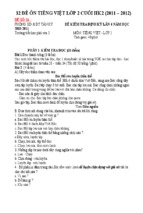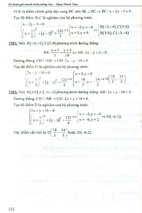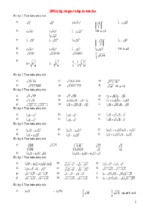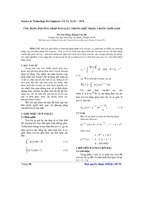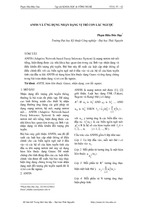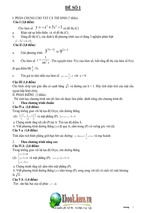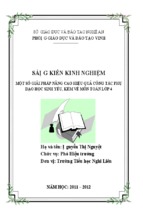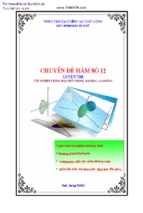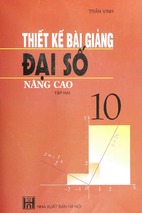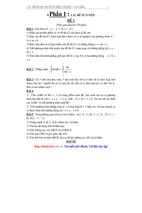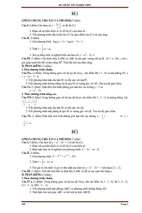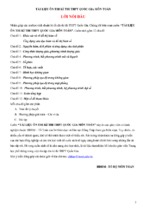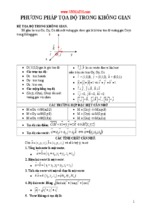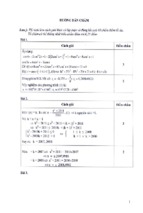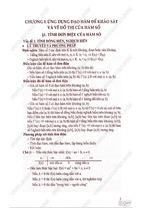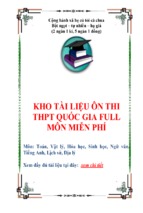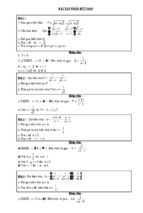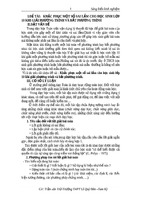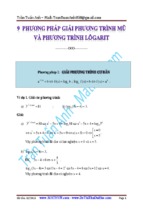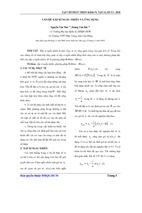Mathematics in everyday life
A study of beliefs and actions
Reidar Mosvold
Department of Mathematics
University of Bergen
2005
Preface
This study is a Dr. philos (doctor philosophiae) study. The study was financed and supported by
Telemarksforsking Notodden (Telemark Educational Research) through Norges Forskningsråd (The
Research Council of Norway).
The study has not been done in isolation. There are several people that have helped me in different
ways. First and foremost, I am immensely grateful to Otto B. Bekken for his advice and support
during recent years. He has assisted me in taking my first steps into the research community in
mathematics education, and without him there would not be a thesis like this.
I will also express my deepest gratitude to all the teachers who let me observe their teaching for
several weeks, and for letting me learn more about their beliefs and teaching strategies while
connecting mathematics to everyday life situations. It has been rewarding to meet so many of you
experienced teachers. You are supposed to be anonymous here, so I am not allowed to display your
names, but I thank you very much for having been so nice, and for having collaborated with me in
such a great way.
I am grateful to Telemarksforsking – Notodden, for giving me this scholarship, and for letting me
work where it suited me best. Special thanks go to Gard Brekke, who has been in charge of this
project. My work with this thesis has been a pleasant journey, and I am now looking forward to
spend some time working with the colleagues in Notodden.
I would also like to thank Marjorie Lorvik for reading my thesis and helping me improve the
English language.
In the first part of my study I was situated in Kristiansand, and had the privilege of participating in
one course in research methodology with Maria Luiza Cestari and another course with Barbara
Jaworski. I feel lucky to have been given the opportunity to discuss my own research project in the
initial phase with them. This was very helpful for me.
At the beginning of my project I spent an inspiring week in Bognor Regis, in the southern part of
England. I want to give special thanks to Afzal Ahmed and his colleagues for their hospitality
during that visit, and for giving me so many ideas for my project. I look back on the days in Bognor
Regis with great pleasure, as a perfect early inspiration for my work.
I also spent some wonderful days in the Netherlands together with Otto. B. Bekken and Maria Luiza
Cestari. There I got the opportunity to meet some of the most important Dutch researchers in the
field. Thanks go to Jan van Maanen for great hospitality in our visit to Groningen and Utrecht, and
to Barbara van Amerom for inviting us to the celebration dinner after we witnessed her dissertation
defence, and to Jan de Lange and his colleagues at the Freudenthal Institute for giving us some
interesting days learning more about their research and projects.
In the Spring of 2003 I was lucky to spend a month at UCLA and the Lesson Lab in California.
Thanks are due to Jim Stigler and Ron Gallimore for opening the doors at Lesson Lab to make the
study of videos from the TIMSS 1999 Video Study possible, and to Angel Chui and Rossella
Santagata for assisting with all practical issues.
I would also like to thank Ted Gamelin and his colleagues at the mathematics department at UCLA
for giving me some inspirational weeks there. Thanks are due to Carolina DeHart, for letting me
participate in her lessons for teacher students, and to the people of the LuciMath group for all the
information about this interesting project, and to Phil Curtis for letting me use his office while I was
in Los Angeles. I remember the days of work in that office where I had the best possible view of the
beautiful UCLA campus, with great pleasure.
i
I am immensely grateful for having been given the opportunity to meet and get to know some of the
most prominent researchers in the field on these visits, and on conferences that I have attended.
Last but not least, I also express my deepest gratitude to my parents, for always having encouraged
me and supported me in every possible way. I would also like to thank my wife, Kristine. Before I
started working with my PhD we did not even know each other. Now we are happily married. The
last years have therefore been a wonderful journey for me in many ways. Thank you for supporting
me in my work and thank you for being the wonderful person that you are! Thanks also to my
parents in-law for letting me use their house as an office for about a year.
Notodden, August 2004
Reidar Mosvold
Revised preface
During this process there have been many revisions to the original document, and it is difficult to
list them all. The most significant revisions, however, have been the changes and additions made to
chapters 6, 10 and 11. A chapter 1.6 has been added, and there have been additions and changes to
chapter 2 as well as chapters 7, 8 and 9. Here I would like to thank the committee at the University
of Bergen, who reviewed the thesis and gave me many constructive comments.
I would also like to thank my colleague Åse Streitlien for reading through my thesis and giving me
several useful comments and suggestions for my final revision.
Many things have happened since last August. The main event is of course that I have become a
father! So, I would like to dedicate this thesis to our beautiful daughter Julie and my wife Kristine. I
love you both!
Sandnes, August 2005
Reidar Mosvold
ii
Notes
In the beginning there are some general notes that should be made concerning some of the
conventions used in this thesis. On several pages in this thesis some small text boxes have been
placed among the text. The aim has been mainly to emphasise certain parts of the content, or to
highlight a quote from one of the teachers, and we believe this could assist in making the text easier
to read and navigate through.
Some places in the text, like in chapters 1.6 and 2.1, some text boxes have been included with
quotes from Wikipedia, the free encyclopedia on the internet (cf. http://en.wikipedia.org). These
quotes are not to be regarded as part of the theoretical background for the thesis, but they are rather
to be considered as examples of how some of the concepts discussed in this thesis have been
defined in more common circles (as opposed to the research literature in mathematics education).
The data material from the study of Norwegian teachers (cf. chapters 8 and 9) was originally in
Norwegian. The parts from the transcripts, field notes or questionnaire results that have been quoted
here are translated to English by the researcher. The entire data material will appear in a book that
can be purchased from Telemark Educational Research (see http://www.tfn.no). This book will be
in Norwegian, and it will contain summaries of the theory, methodology, findings and discussions,
so that it can serve as a complete (although slightly summarized) presentation of the study in
Norwegian as well as a presentation of the complete data material.
The thesis has been written using Open Office (http://openoffice.org), and all the illustrations, charts
and tables have been made with the different components of this office suite. Some of the
illustrations of textbook tasks as well as the problem from the illustrated science magazine (cf.
chapter 8.10.3) have been scanned and re-drawn in the drawing program in Open Office to get a
better appearance in the printed version of the thesis.
iii
Table of contents
1 Introduction.......................................................................................................................................1
1.1 Reasons for the study.................................................................................................................1
1.2 Aims of the study ......................................................................................................................2
1.3 Brief research overview.............................................................................................................4
1.4 Research questions.....................................................................................................................5
1.5 Hypothesis..................................................................................................................................6
1.6 Mathematics in everyday life.....................................................................................................6
1.7 Summary of the thesis..............................................................................................................11
2 Theory..............................................................................................................................................15
2.1 Teacher beliefs.........................................................................................................................15
2.2 Philosophical considerations....................................................................................................19
2.2.1 Discovery or invention?...................................................................................................21
2.3 Theories of learning.................................................................................................................23
2.4 Situated learning......................................................................................................................24
2.4.1 Development of concepts.................................................................................................25
2.4.2 Legitimate peripheral participation..................................................................................27
2.4.3 Two approaches to teaching.............................................................................................28
2.4.4 Apprenticeship ................................................................................................................30
2.5 Historical reform movements..................................................................................................31
2.5.1 Kerschensteiner’s ‘Arbeitsschule’....................................................................................32
2.6 Contemporary approaches........................................................................................................33
2.6.1 The US tradition...............................................................................................................33
2.6.1.1 The NCTM Standards..............................................................................................33
2.6.1.2 High/Scope schools..................................................................................................34
2.6.1.3 UCSMP – Everyday Mathematics Curriculum........................................................35
2.6.2 The British tradition.........................................................................................................37
2.6.2.1 The Cockroft report..................................................................................................37
2.6.2.2 LAMP – The Low Attainers in Mathematics Project...............................................38
2.6.2.3 RAMP - Raising Achievement in Mathematics Project...........................................40
2.6.3 The Dutch tradition..........................................................................................................43
2.6.3.1 Realistic Mathematics Education.............................................................................45
2.6.4 Germany: ‘mathe 2000’...................................................................................................47
2.6.5 The Japanese tradition......................................................................................................50
2.6.6 The Nordic tradition.........................................................................................................51
iii
2.6.6.1 Gudrun Malmer........................................................................................................51
2.6.6.2 Speech based learning..............................................................................................52
2.6.6.3 Everyday mathematics in Sweden............................................................................54
2.7 Everyday mathematics revisited..............................................................................................56
2.8 Transfer of knowledge?...........................................................................................................60
2.9 Towards a theoretical base.......................................................................................................63
3 Real-life Connections: international perspectives...........................................................................67
3.1 The TIMSS video studies.........................................................................................................67
3.2 Defining the concepts..............................................................................................................68
3.3 The Dutch lessons....................................................................................................................70
3.3.1 Real-life connections........................................................................................................70
3.3.2 Content and sources.........................................................................................................71
3.3.3 Methods of organisation...................................................................................................72
3.3.4 Comparative comments....................................................................................................72
3.4 The Japanese lessons...............................................................................................................74
3.4.1 Real-life connections........................................................................................................74
3.4.2 Content and sources.........................................................................................................75
3.4.3 Methods of organisation...................................................................................................76
3.4.4 Comparative comments....................................................................................................77
3.5 The Hong Kong lessons...........................................................................................................78
3.5.1 Real-life connections........................................................................................................78
3.5.2 Content and sources.........................................................................................................79
3.5.3 Methods of organisation...................................................................................................79
3.5.4 Comparative comments....................................................................................................81
3.6 Summarising............................................................................................................................81
4 Norwegian curriculum development...............................................................................................83
4.1 The national curriculum of 1922/1925....................................................................................83
4.2 The national curriculum of 1939..............................................................................................84
4.3 The national curriculum of 1974..............................................................................................85
4.4 The national curriculum of 1987..............................................................................................86
4.5 The national curriculum of L97 ..............................................................................................87
4.5.1 The preliminary work of L97...........................................................................................88
4.5.2 The concept of ‘mathematics in everyday life’................................................................89
4.6 Upper secondary frameworks..................................................................................................93
4.7 Evaluating L 97 and the connection with real life...................................................................94
4.8 Curriculum reform and classroom change...............................................................................98
iv
5 Textbooks........................................................................................................................................99
5.1 The books.................................................................................................................................99
5.2 Real-life connections in the books.........................................................................................100
5.2.1 Lower secondary textbooks ...........................................................................................100
5.2.2 Upper secondary textbooks............................................................................................102
5.3 Textbook problems................................................................................................................103
5.3.1 ‘Realistic’ problems in lower secondary school.............................................................103
5.3.1.1 Realistic contexts....................................................................................................103
5.3.1.2 Artificial contexts...................................................................................................106
5.3.1.3 Other problems with real-life connections.............................................................107
5.3.1.4 Comments...............................................................................................................109
5.3.2 ‘Realistic’ problems in upper secondary school.............................................................109
5.3.2.1 Realistic contexts....................................................................................................109
5.3.2.2 Artificial contexts...................................................................................................110
5.3.2.3 Comments...............................................................................................................113
5.4 Comparison of the textbooks.................................................................................................113
6 More on our research approach.....................................................................................................117
6.1 Research paradigm.................................................................................................................117
6.1.1 Ethnography...................................................................................................................119
6.1.2 Case study......................................................................................................................120
6.2 The different parts of the study..............................................................................................122
6.2.1 Classroom studies..........................................................................................................122
6.2.1.1 Planning meeting....................................................................................................123
6.2.1.2 Questionnaire..........................................................................................................124
6.2.1.3 Observations...........................................................................................................125
6.2.1.4 Interviews...............................................................................................................128
6.2.1.5 Practical considerations and experiences...............................................................129
6.2.2 The TIMSS 1999 Video Study.......................................................................................130
6.2.3 Textbook analysis...........................................................................................................130
6.3 Triangulation..........................................................................................................................131
6.4 Selection of informants..........................................................................................................132
6.4.1 Teachers.........................................................................................................................132
6.4.2 Videos............................................................................................................................133
6.4.3 Textbooks.......................................................................................................................134
6.5 Analysis of data......................................................................................................................134
6.5.1 Classroom study.............................................................................................................135
v
6.5.1.1 Questionnaire..........................................................................................................135
6.5.1.2 Observations – first phase of analysis....................................................................135
6.5.1.3 Observations – second phase of analysis................................................................139
6.5.1.4 Interviews...............................................................................................................140
6.5.2 Video study....................................................................................................................141
6.5.3 Textbooks.......................................................................................................................141
7 Questionnaire results.....................................................................................................................143
7.1 The questionnaire...................................................................................................................143
7.2 The Likert-scale questions.....................................................................................................143
7.2.1 Real-life connections......................................................................................................144
7.2.2 Projects and group work.................................................................................................145
7.2.3 Pupils formulate problems.............................................................................................146
7.2.4 Traditional ways of teaching..........................................................................................147
7.2.5 Re-invention...................................................................................................................147
7.2.6 Use of other sources.......................................................................................................148
7.2.7 Usefulness and understanding – two problematic issues...............................................149
7.3 The comment-on questions....................................................................................................150
7.3.1 Reconstruction................................................................................................................150
7.3.2 Connections with other subjects.....................................................................................151
7.3.3 Problem solving.............................................................................................................152
7.3.4 Content of tasks..............................................................................................................152
7.4 The list questions...................................................................................................................153
7.5 Comparison of teachers..........................................................................................................154
7.6 Categorisation........................................................................................................................157
7.7 Final comments......................................................................................................................158
8 Three teachers: Their beliefs and actions......................................................................................159
8.1 Curriculum expectations........................................................................................................159
8.2 Setting the scene....................................................................................................................160
8.3 Two phases............................................................................................................................160
8.4 Models of analysis.................................................................................................................160
8.5 Brief comparison....................................................................................................................161
8.6 Karin’s beliefs........................................................................................................................165
8.6.1 Practice theories.............................................................................................................165
8.6.2 Content and sources.......................................................................................................166
8.6.3 Activities and organisation.............................................................................................167
8.7 Ann’s beliefs..........................................................................................................................168
vi
8.7.1 Practice theories.............................................................................................................168
8.7.2 Content and sources.......................................................................................................169
8.7.3 Activities and organisation.............................................................................................169
8.8 Harry’s beliefs........................................................................................................................170
8.8.1 Practice theories.............................................................................................................171
8.8.2 Content and sources.......................................................................................................172
8.8.3 Activities and organisation.............................................................................................173
8.9 Into the classrooms................................................................................................................174
8.10 Harry’s teaching...................................................................................................................175
8.10.1 Fibonacci numbers.......................................................................................................175
8.10.2 Pythagoras’ theorem.....................................................................................................176
8.10.3 Science magazine.........................................................................................................178
8.10.4 Bicycle assignment.......................................................................................................179
8.11 Ann’s teaching.....................................................................................................................181
8.11.1 Construction of 60 degrees...........................................................................................181
8.11.2 Area of figures..............................................................................................................182
8.11.3 Size of an angle............................................................................................................183
8.11.4 Blackboard teaching.....................................................................................................184
8.12 Mathematics day..................................................................................................................185
8.13 Karin’s teaching...................................................................................................................187
8.13.1 Lazy mathematicians....................................................................................................187
8.13.2 Grandma’s buttons.......................................................................................................189
8.13.3 If I go shopping............................................................................................................190
8.13.4 Textbook teaches..........................................................................................................191
8.13.5 How many have you slept with?..................................................................................191
9 Five high-school teachers: Beliefs and actions..............................................................................193
9.1 Curriculum expectations........................................................................................................193
9.2 Questionnaire results..............................................................................................................194
9.3 Models of analysis.................................................................................................................198
9.4 Jane’s beliefs..........................................................................................................................198
9.4.1 Practice theories.............................................................................................................199
9.4.2 Content and sources.......................................................................................................199
9.4.3 Activities and organisation.............................................................................................200
9.5 George’s beliefs.....................................................................................................................201
9.5.1 Practice theories.............................................................................................................201
9.5.2 Content and sources.......................................................................................................202
vii
9.5.3 Activities and organisation.............................................................................................203
9.6 Owen’s beliefs.......................................................................................................................203
9.6.1 Practice theories.............................................................................................................204
9.6.2 Content and sources.......................................................................................................204
9.6.3 Activities and organisation.............................................................................................204
9.7 Ingrid’s beliefs.......................................................................................................................205
9.7.1 Practice theories.............................................................................................................205
9.7.2 Content and sources.......................................................................................................206
9.7.3 Activities and organisation.............................................................................................206
9.8 Thomas’ beliefs......................................................................................................................206
9.8.1 Practice theories.............................................................................................................206
9.8.2 Content and sources.......................................................................................................207
9.8.3 Activities and organisation.............................................................................................207
9.9 Into the classrooms................................................................................................................208
9.10 Jane’s teaching.....................................................................................................................209
9.10.1 Mathematics in the kitchen..........................................................................................209
9.10.2 Is anyone here aunt or uncle?.......................................................................................209
9.10.3 Techno sticks and angles..............................................................................................209
9.10.4 I am going to build a garage.........................................................................................210
9.10.5 Pythagoras....................................................................................................................210
9.11 George’s teaching................................................................................................................210
9.11.1 Trigonometry and Christmas cookies..........................................................................210
9.12 Owen’s teaching...................................................................................................................211
9.12.1 Areas............................................................................................................................211
9.13 The teaching of Thomas and Ingrid.....................................................................................212
9.13.1 Cooperative groups......................................................................................................212
10 Discussions and answers.............................................................................................................213
10.1 Activities and organisation..................................................................................................213
10.1.1 Cooperative learning....................................................................................................213
10.1.2 Re-invention.................................................................................................................215
10.1.3 Projects.........................................................................................................................218
10.1.4 Repetitions and hard work...........................................................................................220
10.2 Content and sources.............................................................................................................221
10.2.1 Textbooks.....................................................................................................................221
10.2.2 Curriculum...................................................................................................................224
10.2.3 Other sources................................................................................................................226
viii
10.3 Practice theories...................................................................................................................228
10.3.1 Teaching and learning..................................................................................................228
10.3.2 Vocational relevance....................................................................................................229
10.3.3 Connections with everyday life....................................................................................231
10.4 Answering the research questions........................................................................................235
10.4.1 Are the pupils encouraged to bring their experiences into class?................................235
10.4.2 Do the teachers use examples from the media?...........................................................235
10.4.3 Are the pupils involved in a process of reconstruction or re-invention?.....................236
10.4.4 What sources other than the textbook are used?..........................................................236
10.4.5 Do they use projects and more open tasks? .................................................................237
10.4.6 How do they structure the class, trying to achieve these goals?..................................237
10.4.7 Answering the main questions.....................................................................................237
11 Conclusions.................................................................................................................................241
11.1 Practice theories...................................................................................................................242
11.2 Contents and sources...........................................................................................................245
11.3 Activities and organisation..................................................................................................247
11.4 Implications of teacher beliefs.............................................................................................249
11.5 Curriculum - textbooks – teaching.......................................................................................252
11.6 Definition of concepts..........................................................................................................253
11.7 How problems can be made realistic...................................................................................254
11.8 Lessons learned....................................................................................................................256
11.9 The road ahead.....................................................................................................................257
12 Literature......................................................................................................................................261
13 Appendix 1: Everyday mathematics in L97.................................................................................273
14 Appendix 2: Questionnaire..........................................................................................................279
15 Appendix 3: Illustration index ....................................................................................................285
16 Appendix 4: Table index.............................................................................................................287
ix
Mathematics in everyday life
1 Introduction
1.1
Reasons for the study
As much as I would like for this study to have been initiated by my own brilliant ideas, claiming so
would be wrong. After having finished my Master of Science thesis, in which I discussed the use of
history in teaching according to the so-called genetic principle, I was already determined to go for a
doctorate. I only had vague ideas about what the focus of such a study could be until my supervisor
one day suggested ‘everyday mathematics’. Having thought about that for a while, many pieces of a
puzzle I hardly knew existed seemed to fit into a beautiful picture. I could only wish it was a picture
that originated in my own mind, but it is not.
In my MS thesis I indicated a theory of genesis that not only concerned incorporating the history of
mathematical ideas, methods and concepts, but was more a way of defining the learning of
mathematics as a process of genesis, or development. This process could be historically grounded,
in what we might call historical genesis (or a historical genetic method), but we could also use
concepts like logical genesis, psychological genesis, contextual genesis or situated genesis of
mathematical concepts and ideas to describe the idea. The genetic principle is not a new idea, and it
is believed by many to originate in the work of Francis Bacon (1561-1626), or even earlier. Bacon’s
‘natural method’ implied a teaching practice that starts with situations from everyday life:
When Bacon’s method is to be applied in teaching, everyday problems, the so-called specific cases,
should be the outset, only later should mathematics be made abstract and theoretical. Complete
theorems should not be the starting point; instead such theorems should be worked out along the way
(Bekken & Mosvold, 2003b, p. 86).
Reviewing my own work, I realised that genesis principles (often called a ‘genetic approach’) could
be applied as a framework for theories of learning with connections to real life also. When I
discovered this, my entire work suddenly appeared to fall into place like the pieces of a marvellous
puzzle. Since I cannot regard the image of this puzzle as my work only, I will from now on use the
pronoun ‘we’ instead of ‘I’.
A genesis perspective could be fruitful when studying almost any issue in mathematics education. In
this study we were particularly interested in ways of connecting mathematics with real or everyday
life. We wanted to focus on the development of these ideas in history and within the individual.
Starting with an interest in connecting mathematics with real life, or what we could now place
within a paradigm of contextual genesis, we also decided to focus on teachers and their teaching
(particularly on experienced teachers). The idea of studying experienced teachers could be linked
with a famous statement that occurred in one of Niels Henrik Abel’s notebooks, and this could also
serve as an introduction to our study:
It appears to me that if one wants to make progress in mathematics one should study the masters and
not the pupils (Bekken & Mosvold, 2003b, p. 3).
This statement was initially made in a different connection than this, but we believe that it is also
important to study ‘master teachers’ if one wants to make progress in teaching. This is why we in
our study chose to focus on experienced teachers particularly. Behind that choice was an underlying
assumption that many teachers have years of experience in teaching mathematics, and many of these
teachers have some wonderful teaching ideas. Unfortunately the experience and knowledge of a
1
1 Introduction
teacher all too often dies with the teacher, and his ideas do not benefit others. We believe that there
should be more studies of master teachers in order to collect some of their successful ideas and
methods. These ideas should be incorporated in a common body of knowledge about the teaching of
mathematics.
1.2
Aims of the study
The focus of interest in this study is both connected with content and methods of work. The content
is closely connected with ideas of our national curriculum (which will be further discussed in
chapter 4). We wish to make a critical evaluation of the content of the curriculum, when it comes to
the issues of interest in this study, and we wish to make comparisons with the national development
in other countries.
There have been national curricula in Norway since 1890, and before that there were local
frameworks ever since the first school law was passed around 1739. Laws about schools have been
passed, and specific plans have been made in order to make sure these laws were followed in the
schools. The ideas about schools and teaching have changed over the years. We have studied a few
aspects of our present curriculum, and this will serve as a basis for our research questions and plans.
Norway implemented a new national curriculum for the grades 1-10 in 1997. The general
introductory part also concerned upper secondary education (in Norway called ‘videregående
skole’). This curriculum has been called L97 for short. Because it is still relatively new, we have not
educated a single child throughout elementary school according to L97. Its effects can therefore
hardly be fully measured yet, and the pupils who start their upper secondary education have all gone
through almost half of their elementary school years with the old curriculum. Long-term effects of
the principles and ideas of L97 can therefore hardly be measured at this time. Only a small number
of the teachers in the Norwegian elementary school today have gone through a teacher education
that followed this new curriculum, and all of them have their experience from schools and teachers
that followed older curricula. However, in spite of all this one should expect the teaching in
elementary and upper secondary school to follow the lines of L97 now (at least to some extent).
L97 was inspired by the Cockroft report (Cockroft, 1982), the
NCTM standards (NCTM, 1989) and recent research in
mathematics education. The aims and guidelines for our
contemporary national curriculum appear as well considered, and
the curriculum itself has an impressive appearance. In our
classroom studies we wanted to find out how the principles of L97 have been implemented in the
classrooms. A hypothesis suggests that most teachers teach the way they have been taught
themselves. Experience shows that there is quite a long way from a well-formed set of principles to
actual changes in classrooms. Another issue is that every curriculum is subject to the teacher’s
interpretation. Because of this we do not expect everything to be as the curriculum intends. But we
do believe that many teachers have good ideas about teaching and learning, and it is some of these
good ideas that we have aimed to discover. Together with the teachers we have then reflected upon
how things can be done better.
We want to find out how the
principles of L97 are
implemented in classrooms.
The teaching of mathematics in Norwegian schools is, or at least should be, directed by the national
curriculum. In any study of certain aspects of school and teaching, L97 is therefore a natural place to
start. We will look at a few important phrases here:
2
Mathematics in everyday life
The syllabus seeks to create close links between school mathematics and mathematics in the outside world.
Day-to-day experience, play and experiment help to build up its concepts and terminology (RMERC, 1999, p.
165)
Everyday life situations should thereby form a basis for the teaching of mathematics. ‘Mathematics
in everyday life’ was added as a new topic throughout all ten years of compulsory education.
Learners construct their own mathematical concepts. In that connection it is important to emphasise
discussion and reflection. The starting point should be a meaningful situation, and tasks and problems
should be realistic in order to motivate pupils (RMERC, 1999, p. 167).
These two points: the active construction of knowledge by the pupils and the connection with
school mathematics and everyday life, has been the main focus of this study. L97 presents this as
follows:
The mathematics teaching must at all levels provide pupils with opportunities to:
carry out practical work and gain concrete experience;
investigate and explore connections, discover patterns and solve problems;
talk about mathematics, write about their work, and formulate results and solutions;
exercise skills, knowledge and procedures;
reason, give reasons, and draw conclusions;
work co-operatively on assignments and problems (RMERC, 1999, pp. 167-168).
The first area of the syllabus, mathematics in everyday life, establishes the subject in a social and
cultural context and is especially oriented towards users. The further areas of the syllabus are based on
main areas of mathematics (RMERC, 1999, p. 168).
Main stages
Main areas
Lower
secondary
stage
Mathematics Numbers Geometry Handling Intermediate
in everyday and
data
graphs and
life
algebra
functions
Intermediate Mathematics Numbers Geometry Handling
stage
in everyday
data
life
Primary
stage
Mathematics Numbers Space
in everyday
and shape
life
Table 1 Main areas in L97
As we can see from the table above, ‘mathematics in everyday’ life has become a main area of
mathematics in Norwegian schools, and this should imply an increased emphasis on real-life
connections.
Although a connection with everyday life has been mentioned in previous curricula also, there has
been a shift of focus. The idea that the pupils should learn to use mathematics in practical situations
from everyday life has been present earlier, but in L97 the situations from real life were supposed to
be the starting point rather than the goal. Instead of mathematics being a training field for real life
the situations from real life are supposed to be starting points. When the pupils are working with
these problems they should reach a better understanding of the mathematical theories. This is an
3
1 Introduction
Situations from real life
are supposed to be a
starting point.
important shift of focus, and in our study we wanted to investigate
how teachers have understood and implemented these ideas in their
teaching.
The ideas of the curriculum on these points were examined in this
study. The curriculum content was also examined, and we aimed at
finding out how the textbooks meet the curricular demands, as well as how the teachers think and
act. We have observed how these ideas were carried out in actual classrooms and then tried to
gather some thoughts and ideas on how it can be done better.
Connections with real life are not new in curricula, and they are not specific for the Norwegian
tradition only. New Zealand researcher Andrew J.C. Begg states:
In mathematics education the three most common aims of our programs are summed up as:
Personal – to help students solve the everyday problems of adult life;
Vocational – to give a foundation upon which a range of specialised skills can be built;
Humanistic – to show mathematics as part of our cultural heritage (Begg, 1984, p. 40).
Our project has built on research from other countries, and we wish to contribute to this research. In
research on mathematics education, mathematics is often viewed as a social construct which is
established through practices of discourse (Lerman, 2000). This is opposed to a view of
mathematics as a collection of truths that are supposed to be presented to the pupils in appropriate
portions.
1.3
Brief research overview
The work consisted of a theoretical study of international research, a study of videos from the
TIMSS 1999 Video Study of seven countries, a study of textbooks, a study of curriculum papers,
and a classroom study of Norwegian teachers, their beliefs and actions concerning these issues.
In the theoretical study we investigated research done in this area, to uncover some of the ideas of
researchers in the past and the present. We focused on research before and after the Cockroft Report
in Britain, NCTM (National Council of Teachers of Mathematics) and the development in
curriculum Standards in the US, research from the Freudenthal Institute in the Netherlands, the
theories of the American reform pedagogy, the theories of situated learning and the Nordic research.
Through examining all these theories and research projects, we have tried to form a theoretical
framework for our own study.
The contemporary national curriculum, L97, was of course the most important to us, but we have
also studied previous curricula in Norway, from the first one in 1739 up till the present. We have
tried to find out if the thoughts mentioned above are new ones, or if they have been part of the
educational system in earlier years. This analysis served as a background for our studies. The
curriculum presents one set of ideas on how to connect mathematics with real life, and the textbooks
might represent different interpretations of these ideas. Teachers often use the textbooks as their
primary source rather than the curriculum, and we have therefore studied how the textbooks deal
with the issue.
The main part of our study was a qualitative research study, containing interviews with teachers, a
questionnaire survey, and observations of classroom practice. This was supported by investigations
of textbooks and curriculum papers, analysis of videos from the TIMSS 1999 Video Study, and a
review of theory. The qualitative data were intended to help us discover connections between the
4
Mathematics in everyday life
teachers’ educational background and their beliefs about the subject, teaching and learning on the
one hand, and about classroom practice and methods of work on the other hand.
1.4
Research questions
A main part of any research project is to define a research problem, and to form some reasonable
research questions. This was an important process in the beginning of this study, and it became
natural to have strong connections with the curriculum. The national curriculum is, or should be, the
working document of Norwegian teachers. We have been especially interested in how they think
about and carry out ideas concerning the connection with everyday life.
1)
What are the teachers’ beliefs about connecting school
mathematics and everyday life?
2)
What ideas are carried out in their teaching practice?
It was of particular interest for us to identify the views of the teachers, when connections with
everyday life were concerned, and to see how these views and ideas affected their teaching. A
reasonable set of questions might be:
Are the pupils encouraged to bring their experiences into
class?
Are the pupils involved in a process of reconstruction or
re-invention?
What sources other than the textbook do teachers use?
Do they encourage projects and open tasks?
Do the teachers use examples from the media?
How do they structure the class, in trying to achieve
these goals?
To these questions we have added a few sub-questions that could assist when attempting to answer
the two main questions and to learn more about the strategies and methods they use to connect with
everyday life:
Being aware of the fact that it is hard to answer these questions when it comes to all aspects of the
mathematics curriculum, it is probably wise to focus on one or two areas of interest. The strategies
for implementing these ideas in the teaching of algebra might differ from the strategies used when
teaching probability, for instance. We chose to focus on the activities and issues of organisation
rather than the particular mathematical topics being taught by the teachers at the time of our
classroom observations.
The two main research questions might be revised slightly: How can teachers organise their
teaching in order to promote activities where the pupils are actively involved in the construction of
mathematical knowledge, and how can these activities be connected with real life? The subquestions could easily be adopted for these questions also. From the sub-questions, we already see
that pupil activity is naturally incorporated into these ideas. It is therefore fair to say that activity is a
central concept, although it is an indirect and underlying concept more than a direct one.
5
1 Introduction
Important questions that are connected with the questions above, at least on a meta-level, are:
How do we cope with the transformation of knowledge from specific, real-life
situations to the general?
How does the knowledge transform from specific to general?
How does the knowledge transform in/apply to other context situations?
These are more general questions that we might not be able to answer, at least not in this study, but
they will follow us throughout the work.
1.5
Hypothesis
Based on intuition and the initial research questions, we can present a hypothesis that in many
senses is straightforward, and that has obvious limitations, but that anyhow is a hypothesis that can
be a starting point for the analysis of our research.
The population of teachers can be divided into three groups when it comes to their attitudes and
beliefs about real-life connections. Teachers have multiple sets of beliefs and ideas and therefore
cannot easily be placed within a simplified category. We present the hypothesis that teachers of
mathematics have any of these attitudes towards real-life connections:
Positive
Negative
Negotiating (in-between)
We believe that the teachers in our study can also be placed within one of these groups or
categories. Placing teachers in such categories, no matter how interesting that might be, will only be
of limited value. We will not narrow down our study to such a description and categorisation.
Instead we have tried to gather information about the actions of teachers in each of these categories
when it comes to real-life connections, and we have also tried to discover some of the thinking that
lies behind their choices. A main goal for our study is therefore to generate new theory, so that we
can replace this initial model with a more appropriate one. Such knowledge can teach us valuable
lessons about connecting mathematics with real life, at least this is what we believe.
Our interest was therefore not only to analyse what the teachers thought about these matters and
place them within these three categories, but to use this as a point of departure in order to generate
new theory. We not only wanted to study what beliefs they had, but also to study what they actually
did to achieve a connection with everyday life, or what instructional practices they chose. It was our
intention to study the teaching strategies a teacher might choose to fulfil the aims of the curriculum
when it comes to connecting mathematics with everyday life; the content and materials they used
and the methods of organising the class.
1.6
Mathematics in everyday life
This thesis is based on the Norwegian curriculum (L97) because this was the current curriculum at
the time of our study. The national curriculum is the main working document for Norwegian
teachers, and the connection with mathematics and everyday life has been the key focus here.
6
- Xem thêm -

